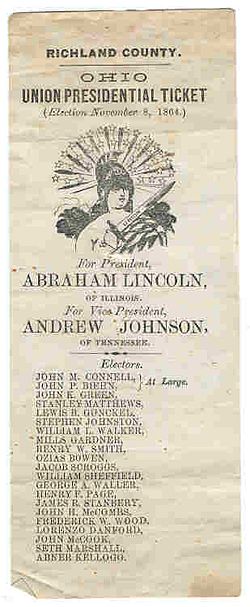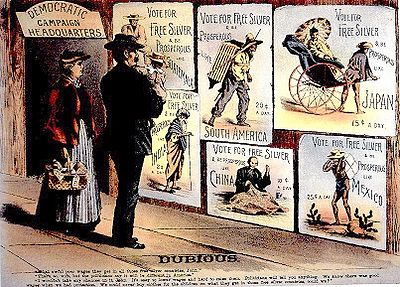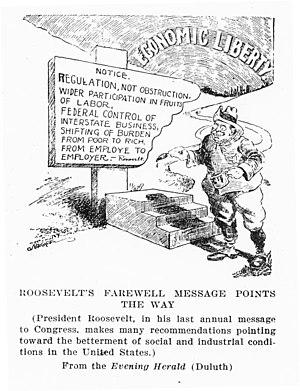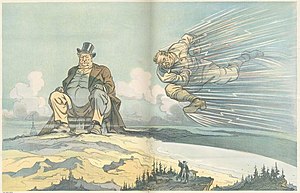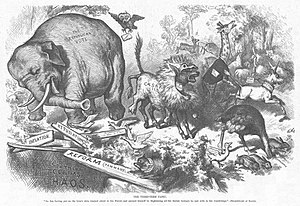Republican Party (United States), history: Difference between revisions
imported>Richard Jensen (import from Wiki (parts by RJ)) |
imported>Richard Jensen (import from Wiki (most by RJ)) |
||
| Line 1: | Line 1: | ||
The [[Republican Party (United States)|Republican Party]] of the [[United States]] was established in 1854 and is one of the two dominant parties today. This article covers its history to 1980. ''For the current party and its history since 1980, see [[Republican Party (United States)]]''. | |||
[[Image:Birthplace of the US Republican Party 1.jpg|thumb|right|The Schoolhouse in Ripon, Wisconsin where the Republican Party was first organized locally in 1854]] | [[Image:Birthplace of the US Republican Party 1.jpg|thumb|right|The Schoolhouse in Ripon, Wisconsin where the Republican Party was first organized locally in 1854]] | ||
Revision as of 23:50, 22 April 2007
The Republican Party of the United States was established in 1854 and is one of the two dominant parties today. This article covers its history to 1980. For the current party and its history since 1980, see Republican Party (United States).
Creation
The Republican party was created in 1854 in opposition to the Kansas-Nebraska Act that would have allowed the expansion of slavery into Kansas. The Republican activists denounced the act as proof of the power of the Slave Power--the powerful class of slaveholders who were conspiring to control the federal government and to spread slavery nationwide. The name "Republican" gained such favor in 1854 because "republicanism" was the paramount political value the new party meant to uphold. The name also echoed the former Jeffersonian party of the First Party System. The party founders adopted the name "Republican" to indicate it was the carrier of "republican" beliefs about civic virtue, and opposition to aristocracy and corruption. [1]
Two small cities of the Yankee diaspora, Ripon, Wisconsin and Jackson, Michigan, claim the birthplace honors. [2] Ripon held the first county convention on March 20, 1854. Jackson held the first statewide convention where delegates on July 6, 1854 declared their new party opposed to the expansion of slavery into new territories and selected a state-wide slate of candidates. The Midwest took the lead in forming state party tickets, while the eastern states lagged a year or so. There were no efforts to organize the party in the South, apart from a few areas adjacent to free states.
More than just expansion, the party opposed what it called the Slave Power, that is the political control over the national government exerted by southern slave owners. Besides opposition to slavery, the new party put forward a progressive vision --emphasizing higher education, banking, railroads, industry and cities, while promising free homesteads to farmers. They vigorously argued that free-market labor was superior to slavery and the very foundation of civic virtue and true American values - this is the "Free Soil, Free Labor, Free Men" ideology explored by historian Eric Foner [3]. The Republicans absorbed the previous traditions of its members, most of whom had been Whigs, and some of whom had been Democrats or members of third parties (especially the Free Soil Party and American Party). Many Democrats who joined up were rewarded with governorships: (Nathaniel P. Banks of Massachusetts, Kinsley Bingham of Michigan, William H. Bissell of Illinois, Salmon P. Chase of Ohio, Hannibal Hamlin of Maine, Samuel J. Kirkwood of Iowa, Ralph Metcalf of New Hampshire, Lot Morrill of Maine, and Alexander Randall of Wisconsin) or seats in the U.S. Senate (Bingham and Hamlin, as well as James R. Doolittle of Wisconsin, John P. Hale of New Hampshire, Preston King of New York, Lyman Trumbull of Illinois, and David Wilmot of Pennsylvania.) Since its inception, its chief opposition has been the Democratic Party, but the amount of flow back and forth of prominent politicians between the two parties was quite high from 1854 to 1896.
Historians have explored the ethnocultural foundations of the party, along the line that ethnic and religious groups set the moral standards for their members, who then carried those standards into politics. The churches also provided social networks that politicians used to sign up voters. The pietistic churches, heavily influenced by the revivals of the Second Great Awakening, emphasized the duty of the Christian to purge sin from society. Sin took many forms--alcoholism, polygamy and slavery became special targets for the Republicans. The Yankees, who dominated New England, much of upstate New York, and much of the upper Midwest were the strongest supporters of the new party. This was especially true for the pietistic Congregationalists and Presbyterians among them and (during the war), the Methodists, along with Scandinavian Lutherans. The Quakers were a small tight-knit group that was heavily Republican. The liturgical churches (Roman Catholic, Episcopal, German Lutheran), by contrast, largely rejected the moralism of the GOP; most of their adherents voted Democratic. [4]
1854-1860
John C. Frémont ran as the first Republican nominee for President in 1856, using the political slogan: "Free soil, free labor, free speech, free men, Frémont." Although Frémont's bid was unsuccessful, the party showed a strong base. It dominated in New England, New York and the northern Midwest, and had a strong presence in the rest of the North. It had almost no support in the South, where it was roundly denounced in 1856-60 as a divisive force that threatened civil war. The election of Abraham Lincoln in 1860 ended the domination of the fragile coalition of pro-slavery southern Democrats and conciliatory northern Democrats which had existed since the days of Andrew Jackson. Instead, a new era of Republican dominance based in the industrial and agricultural north ensued. Republicans still often refer to their party as the "party of Lincoln" in honor of the first Republican President.
- See also: American election campaigns in the 19th century
- See also: Third Party System
Third Party System: 1860-1890
The Third Party System was dominated by the Republican party (it lost in 1884 and 1892.) Lincoln proved brilliantly successful in uniting the factions of his party to fight for the Union.[5] However he usually fought the Radical Republicans who demanded harsher measures. Most Democrats at first were War Democrats, and supportive until the fall of 1862. When Lincoln added the abolition of slavery as a war goal, many war Democrats became "peace Democrats." All the state Republican parties accepted the antislavery goal except Kentucky. In Congress, the party passed major legislation to promote rapid modernization, including a national banking system, high tariffs, an income tax, many excise taxes, paper money issued without backing ("greenbacks"), a huge national debt, homestead laws, and aid to education and agriculture. The Republicans denounced the peace-oriented Democrats as Copperheads and won enough War Democrats to maintain their majority in 1862; in 1864, they formed a coalition with many War Democrats as the National Union Party which reelected Lincoln easily. During the war, upper middle-class men in major cities formed Union Leagues, to promote and help finance the war effort.
Reconstruction: Blacks, Carpetbaggers and Scalawags
In Reconstruction, how to deal with the ex-Confederates and the freed slaves, or Freedmen, were the major issues. By 1864, Radical Republicans controlled Congress and demanded more aggressive action against slavery, and more vengeance toward the Confederates. Lincoln held them off, but just barely. Republicans at first welcomed President Andrew Johnson; the Radicals thought he was one of them and would take a hard line in punishing the South. Johnson however broke with them and formed a loose alliance with moderate Republicans and Democrats. The showdown came in the Congressional elections of 1866, in which the Radicals won a sweeping victory and took full control of Reconstruction, passing key laws over the veto. Johnson was impeached by the House, but acquitted by the Senate. With the election of Ulysses S. Grant in 1868, the Radicals had control of Congress, the party and the Army, and attempted to build a solid Republican base in the South using the votes of Freedmen, Scalawags and Carpetbaggers, supported directly by U.S. Army detachments. Republicans all across the South formed local clubs called Union Leagues that effectively mobilized the voters, discussed issues, and when necessary fought off Ku Klux Klan attacks. Thousands died on both sides.
Grant supported radical reconstruction programs in the South, the 14th Amendment, and equal civil and voting rights for the freedmen. Most of all he was the hero of the war veterans, who marched to his tune. The party had become so large that factionalism was inevitable; it was hastened by Grant's tolerance of high levels of corruption typified by the Whiskey Ring. The "Liberal Republicans" split off in 1872 on the grounds that it was time to declare the war finished and bring the troops home. Many of the founders of the GOP joined the movement, as did many powerful newspaper editors. They nominated Horace Greeley, who gained unofficial Democratic support, but was defeated in a landslide. The depression of 1873 energized the Democrats. They won control of the House and formed "Redeemer" coalitions which recaptured control of each southern state, in some cases using threats and violence.
Reconstruction came to an end when the contested election of 1876 was awarded by a special electoral commission to Republican Rutherford B. Hayes who promised, through the unofficial Compromise of 1877, to withdraw federal troops from control of the last three southern states. The region then became the Solid South, giving overwhelming majorities of its electoral votes and Congressional seats to the Democrats until 1964.
In terms of racial issues, "White Republicans as well as Democrats solicited black votes but reluctantly rewarded blacks with nominations for office only when necessary, even then reserving the more choice positions for whites. The results were predictable: these half-a-loaf gestures satisfied neither black nor white Republicans. The fatal weakness of the Republican party in Alabama, as elsewhere in the South, was its inability to create a biracial political party. And while in power even briefly, they failed to protect their members from Democratic terror. Alabama Republicans were forever on the defensive, verbally and physically." [Woolfolk p 134]
Social pressure eventually forced most Scalawags to join the conservative/Democratic Redeemer coalition. A minority persisted and formed the "tan" half of the "Black and Tan" Republican party, a minority in every southern state after 1877. (DeSantis 1998)
Gilded Age: 1877-1890
The "GOP" (as it was now nicknamed) split into factions in the late 1870s. The Stalwarts, followers of Senator Conkling, defended the spoils system. The Half-Breeds, who followed Senator James G. Blaine of Maine, pushed for Civil service reform. Independents who opposed the spoils system altogether were called "Mugwumps". In 1884 they rejected James G. Blaine as corrupt and helped elect Democrat Grover Cleveland; most returned to the party by 1888.
As the Northern post-bellum economy boomed with heavy and light industry, railroads, mines, and fast-growing cities, as well as prosperous agriculture, the Republicans took credit and promoted policies to keep the fast growth going. They supported big business generally, hard money (i.e. the gold standard), high tariffs, and high pensions for Union veterans. By 1890, however, the Republicans had agreed to the Sherman Anti-Trust Act and the Interstate Commerce Commission in response to complaints from owners of small businesses and farmers. The high McKinley Tariff of 1890 hurt the party and the Democrats swept to a landslide in the off-year elections, even defeating McKinley himself.
Ethnocultural Politics: pietistic Republicans versus liturgical Democrats
From 1860 to 1912, the Republicans took advantage of the association of the Democrats with "Rum, Romanism, and Rebellion". Rum stood for the liquor interests and the tavernkeepers, in contrast to the GOP, which had a strong dry element. "Romanism" meant Catholics, especially Irish Americans, who ran the Democratic party in every big city, and whom the Republicans denounced for political corruption. "Rebellion" stood for the Confederates who tried to break the Union in 1861, and the Copperheads in the North who sympathized with them.
Demographic trends aided the Democrats, as the German and Irish Catholic immigrants were Democrats, and outnumbered the English and Scandinavian Republicans. During the 1880s and 1890s, the Republicans struggled against the Democrats' efforts, winning several close elections and losing two to Grover Cleveland (in 1884 and 1892). Religious lines were sharply drawn [Kleppner 1979]. Methodists, Congregationalists, Presbyterians, Scandinavian Lutherans and other pietists in the North were tightly linked to the GOP. In sharp contrast, liturgical groups, especially the Catholics, Episcopalians, and German Lutherans, looked to the Democratic party for protection from pietistic moralism, especially prohibition. Both parties cut across the class structure, with the Democrats more bottom-heavy.
Cultural issues, especially prohibition and foreign language schools became important because of the sharp religious divisions in the electorate. In the North, about 50% of the voters were pietistic Protestants (Methodists, Scandinavian Lutherans, Presbyterians, Congregationalists, Disciples of Christ) who believed the government should be used to reduce social sins, such as drinking. Liturgical churches (Roman Catholics, German Lutherans, Episcopalians) comprised over a quarter of the vote and wanted the government to stay out of the morality business. Prohibition debates and referenda heated up politics in most states over a period of decade, as national prohibition was finally passed in 1918 (and repealed in 1932), serving as a major issue between the wet Democracy and the dry GOP. (Kleppner 1979)
| Voting Behavior by Religion, Northern USA Late 19th century | ||
| % Dem | % GOP | |
| Immigrant Groups | ||
| Irish Catholics | 80 | 20 |
| All Catholics | 70 | 30 |
| Confessional German Lutherans | 65 | 35 |
| German Reformed | 60 | 40 |
| French Canadian Catholics | 50 | 50 |
| Less Confessional German Lutherans | 45 | 55 |
| English Canadians | 40 | 60 |
| British Stock | 35 | 65 |
| German Sectarians | 30 | 70 |
| Norwegian Lutherans | 20 | 80 |
| Swedish Lutherans | 15 | 85 |
| Haugean Norwegians | 5 | 95 |
| Natives: Northern Stock | ||
| Quakers | 5 | 95 |
| Free Will Baptists | 20 | 80 |
| Congregational | 25 | 75 |
| Methodists | 25 | 75 |
| Regular Baptists | 35 | 65 |
| Blacks | 40 | 60 |
| Presbyterians | 40 | 60 |
| Episcopalians | 45 | 55 |
| Natives: Southern Stock (living in North) | ||
| Disciples | 50 | 50 |
| Presbyterians | 70 | 30 |
| Baptists | 75 | 25 |
| Methodists | 90 | 10 |
Source: Paul Kleppner, The Third Electoral System 1853-1892 (1979) p 182
Fourth Party System: 1896-1932: The Progressive Era
The election of William McKinley in 1896 is widely seen as a resurgence of Republican dominance and is sometimes cited as a realigning election.
The Fourth Party System was dominated by Republican presidents, with the exception of the two terms of Democrat Woodrow Wilson, 1912-1920. McKinley promised that high tariffs would end the severe hardship caused by the Panic of 1893, and that the GOP would guarantee a sort of pluralism in which all groups would benefit. He denounced William Jennings Bryan, the Democratic nominee, as a dangerous radical whose plans for "Free Silver" at 16-1 (or Bimetallism) would bankrupt the economy.
McKinley relied heavily on industry and the middle classes for his support and cemented the Republicans as the party of business; his campaign manager, Ohio's Mark Hanna, developed a detailed plan for getting contributions from the business world, and McKinley outspent his rival William Jennings Bryan by a large margin. This emphasis on business was in part mitigated by Theodore Roosevelt, McKinley's successor after assassination, who engaged in trust-busting. McKinley was the first president to promote pluralism, arguing that prosperity would be shared by all ethnic and religious groups.
Theodore Roosevelt, who became president in 1901, had the most dynamic personality in the nation. Roosevelt he had to contend with men like Senator Mark Hanna, whom he outmaneuvered to gain control of the convention in 1904 that renominated him. More difficult to handle was conservative House Speaker Joseph Gurney Cannon.
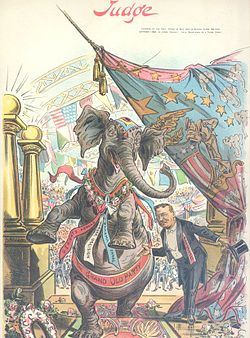
Roosevelt achieved modest legislative gains in terms of railroad legislation and pure food laws. He was more successful in Court, bringing antitrust suits that broke up the Northern Securities trust and Standard Oil. Roosevelt moved left in his last two years in office but was unable to pass major Square Deal proposals. He did succeed in naming his successor Secretary of War William Howard Taft who easily defeated Bryan again in the 1908.
The tariff issue was pulling the GOP apart. Roosevelt tried to postpone the issue but Taft had to meet it head on in 1909 with the Payne-Aldrich Tariff Act. Eastern conservatives led by Nelson A. Aldrich wanted high tariffs on manufactured goods (especially woolens), while Midwesterners called for low tariffs. Aldrich tricked them by lowering the tariff on farm products, which outraged the farmers. Insurgent Midwesterners led by George Norris revolted against the conservatives led by Speaker Cannon. The Democrats won control of the House in 1910, as the rift between insurgents and conservatives widened. In 1912 Roosevelt broke with Taft and tried for a third term. He was outmaneuvered by Taft and lost the nomination. Roosevelt led his delegates out of the convention and created a new party, the Progressive, or "Bull Moose" ticket in the election of 1912. Few party leaders followed him except Hiram Johnson of California. The Roosevelt-caused split in the Republican vote resulted in a decisive victory for Democrat Woodrow Wilson, temporarily interrupting the Republican era.
The Republicans welcomed the Progressive Era at the state and local level. The first important reform mayor was Hazen S. Pingree of Detroit (1890-97) who was elected governor of Michigan in 1896. In New York City the Republicans joined nonpartisan reformers to battle Tammany Hall, and elected Seth Low (1902-03). Golden Rule Jones was first elected mayor of Toledo as a Republican in 1897, but was reelected as an independent when his party refused to renominate him. Many Republican civic leaders, following the example of Mark Hanna, were active in the National Civic Federation, which promoted urban reforms and sought to avoid wasteful strikes.
The party controlled the presidency throughout the 1920s, running on a platform of opposition to the League of Nations, high tariffs, and promotion of business interests. Warren G. Harding, Calvin Coolidge and Herbert Hoover were resoundingly elected in 1920, 1924, and 1928 respectively. The breakaway efforts of Senator Robert LaFollette in 1924 failed to stop a landslide for Coolidge, and his movement fell apart. The Teapot Dome Scandal threatened to hurt the party but Harding died and Coolidge blamed everything on him, as the opposition splintered in 1924. The pro-business policies of the decade seemed to produce an unprecedented prosperity--until the Wall Street Crash of 1929 heralded the Great Depression. Although the party did very well in large cities and among ethnic Catholics in presidential elections of 1920-24, it was unable to hold those gains in 1928. By 1932 the cities--for the first time ever--had become Democratic strongholds.
The African American vote held for Hoover in 1932, but started moving toward Roosevelt. By 1940 the majority of northern blacks were voting Democratic. Southern blacks who could vote (in border states) were split; disenfranchised blacks in the South probably preferred the Republicans.
The Great Depression cost Hoover the presidency with the 1932 landslide election of Franklin D. Roosevelt. Roosevelt's New Deal coalition controlled American politics for most of the next three decades, excepting the two-term presidency of Republican Dwight Eisenhower.
Fifth Party System: 1932-1980
Minority parties tend to factionalize and after 1936 the GOP split into a conservative faction (dominant in the West and Southeast) and a liberal faction (dominant in the Northeast) – combined with a residual base of inherited progressive Republicanism active throughout the century. In 1936 Kansas governor Alf Landon and his young followers defeated the Herbert Hoover faction. Landon generally supported most New Deal programs, but carried only two states in the Roosevelt landslide.
Senator Robert Taft of Ohio represented the Midwestern wing of the party that continued to oppose New Deal reforms and continued to champion isolationism. Thomas Dewey, governor of New York, represented the Northeastern wing of the party. Dewey did not reject the New Deal programs, but demanded more efficiency, more support for economic growth, and less corruption. He was more willing than Taft to support Britain in 1939-40. After the war the isolationists wing strenuously opposed the United Nations, and was half-hearted in opposition to world Communism. Senator William F. Knowland of California, sobriquet Senator from Formosa (Taiwan).
Dwight Eisenhower, an internationalist allied with the Dewey wing, challenged Taft in 1952 on foreign policy issues. The two men were not far apart on domestic issues. Eisenhower's victory broke a 20 year Democratic lock on the White House. Eisenhower did not try to roll back the New Deal, but he did expand the Social Security system and built the Interstate Highway system.
The conservatives in 1964 made a comeback under the leadership of Barry Goldwater who defeated Nelson Rockefeller as the Republican candidate in the 1964 presidential convention. Goldwater was strongly opposed to the New Deal and the United Nations, but he rejected isolationism and containment, calling for an aggressive anti-Communist foreign policy.
Any long-term movement toward the GOP was interrupted by the Watergate Scandal, which forced Nixon to resign in 1974 under threat of impeachment. Gerald Ford succeeded Nixon and gave him a full pardon--thereby giving the Democrats a powerful issue they used to sweep the 1974 off-year elections. Ford never fully recovered, and in 1976 he barely defeated Ronald Reagan for the nomination. The taint of Watergate and the nation's economic difficulties contributed to the election of Democrat Jimmy Carter in 1976, running as a Washington outsider.
Ronald Reagan was elected President in the 1980 election by a landslide vote, not predicted by most voter polling. Running on a "Peace Through Strength" platform to combat the Communist threat and massive tax cuts to revitalize the economy, Reagan's strong but genial persona proved too much for the ineffective and sour Carter. Reagan's election also gave Republicans control of the Senate for the first time in decades. Dubbed the "Reagan Revolution" he fundamentally altered several long standing debates in Washington, namely dealing with the Soviet threat and reviving the economy. His election saw the conservative wing of the party gain control. While reviled by liberal opponents in his day, his proponents contend his programs provided unprecedented economic growth, and spurred the collapse of the former Soviet Union. Currently regarded as one of the most popular and successful presidents in the modern era (1960-present.) He inspired Conservatives to greater electoral victories by being re-elected in a landslide against Walter Mondale in 1984 but oversaw the loss of the Senate in 1986.
Strength of Parties 1977
How the Two Parties Stood after the 1976 Election:
| Party | Republican | Democratic | Independent |
|---|---|---|---|
| Party ID (Gallup) | 22% | 47% | 31% |
| Congressmen | 181 | 354 | |
| House | 143 | 292 | |
| Senate | 38 | 62 | |
| % House popular vote nationally | 42% | 56% | 2% |
| in the East | 41% | 57% | 2% |
| in the South | 37% | 62% | 2% |
| in the Midwest | 47% | 52% | 1% |
| in the West | 43% | 55% | 2% |
| Governors | 12 | 37 | 1 |
| State Legislators | 2,370 | 5,128 | 55 |
| 31% | 68% | 1% | |
| State legislature control | 18 | 80 | 1 * |
| in the East | 5 | 13 | 0 |
| in the South | 0 | 32 | 0 |
| in the Midwest | 5 | 17 | 1 * |
| in the West | 8 | 18 | 0 |
| States' one party control of legislature and governorship |
1 | 29 | 0 |
*The unicameral Nebraska legislature, in fact controlled by the Republicans, is technically nonpartisan.
Source: Everett Carll Ladd Jr. Where Have All the Voters Gone? The Fracturing of America's Political Parties (1978) p.6
Moderate Republicans of 1940-80
The term Rockefeller Republican was used 1960-80 to designate a faction of the party holding "moderate" views similar to those of the late Nelson Rockefeller, governor of New York from 1959 to 1974 and vice president under President Gerald Ford in 1974-77. Before Rockefeller, Tom Dewey, governor of New York 1942-54 and GOP presidential nominee in 1944 and 1948 was the leader. Dwight Eisenhower reflected many of their views. An important leader in the 1950s was Connecticut Republican Senator Prescott Bush, father and grandfather of presidents of George H. W. Bush and George W. Bush. After Rockefeller left the national stage in 1976, this faction of the party was more often called "moderate Republicans," in contrast to the conservatives who rallied to Ronald Reagan. Historically, Rockefeller Republicans were moderate or liberal on domestic and social policies. They favored New Deal programs, including regulation and welfare. They were very strong supporters of civil rights. They were strongly supported by big business on Wall Street (New York City). In fiscal policy they favored balanced budgets and relatively high tax levels to keep the budget balanced. They sought long-term economic growth through entrepreneurships, not tax cuts. In state politics, they were strong supporters of state colleges and universities, low tuition, and large research budgets. They favored infrastructure improvements, such as highway projects. In foreign policy they were internationalists, and anti-Communists. They felt the best way to counter Communism was sponsoring economic growth (through foreign aid), maintaining a strong military, and keeping close ties to NATO. Geographically their base was the Northeast, from Pennsylvania to Maine. Barry Goldwater crusaded against the Rockefeller Republicans, beating Rockefeller narrowly in the California primary of 1964. That set the stage for a conservative resurgence, based in the South and West, in opposition to the Northeast. Ronald Reagan continued in the same theme, but George H. W. Bush was more closely associated with the moderates.
Realignment: The South becomes Republican
In the century after Reconstruction, the white South identified with the Democratic Party. The Democrats' lock on power was so strong, the region was called the Solid South. The Republicans controlled certain parts of the Appalachian mountains, but they sometimes did compete for statewide office in the border states. Before 1964, the southern Democrats saw their party as the defender of the southern way of life, which included a respect for states' rights and an appreciation for traditional southern values. They repeatedly warned against the aggressive designs of Northern liberals and Republicans, as well as the civil rights activists they denounced as "outside agitators." Thus there was a serious barrier to becoming a Republican.
However, since 1964, the Democratic lock on the South has been broken. The long-term cause was that the region was becoming more like the rest of the nation and could not long stand apart in terms of racial segregation. Modernization that brought factories, businesses, and cities, and millions of migrants from the North; far more people graduated from high school and college. Meanwhile the cotton and tobacco basis of the traditional South faded away, as former farmers moved to town or commuted to factory jobs. The immediate cause of the political transition involved civil rights. The civil rights movement caused enormous controversy in the white South with many attacking it as a violation of states' rights. When segregation was outlawed by court order and by the Civil Rights acts of 1964 and 1965, a die-hard element resisted integration, led by Democratic governors Orval Faubus of Arkansas, Lester Maddox of Georgia, and, especially George Wallace of Alabama. These populist governors appealed to a less-educated, blue-collar electorate that on economic grounds favored the Democratic party, but opposed segregation. After passage of the Civil Rights Act most Southerners accepted the integration of most institutions (except public schools). With the old barrier to becoming a Republican removed, traditional Southerners joined the new middle class and the Northern transplants in moving toward the Republican party. Integration thus liberated Southern politics, just as Martin Luther King had promised. Some critics allege that the old racism has not totally disappeared but instead is hidden in the Republican vote, and can be seen in Nixon’s Southern Strategy Template:Specify. Meanwhile the newly enfranchised black voters supported Democratic candidates at the 85-90% level.
The South's transition to a Republican stronghold took decades. First the states started voting Republican in presidential elections--the Democrats countered that by nominating Southerners who could carry some states in the region, such as Jimmy Carter in 1976 and 1980, and Bill Clinton in 1992 and 1996; the strategy did not work with Al Gore in 2000, or John Edwards in 2004. Then the states began electing Republican senators to fill open seats caused by retirements, and finally governors and state legislatures changed sides. Georgia was the last state to fall, with Sonny Perdue taking the governorship in 2002. Republicans aided the process with systematic gerrymandering that protected the African American and Hispanic vote (as required by the Civil Rights laws), but split up the remaining white Democrats so that Republicans mostly would win. In 2006 the Supreme Court endorsed nearly all of the redistricting engineered by Tom DeLay that swung the Texas Congressional delegation to the GOP in 2004.
In addition to its white middle class base, Republicans attracted strong majorities from the evangelical Christian vote, which had been nonpolitical before 1980. The national Democratic Party's support for liberal social stances such as abortion drove many former Democrats into a Republican party that was embracing the conservative views on these issues. Conversely, liberal Republicans in the northeast began to join the Democratic Party. In 1969 in The Emerging Republican Majority, Kevin Phillips, argued that support from Southern whites and growth in the Sun Belt, among other factors, was driving an enduring Republican electoral realignment. Today, the South is again solid, but the reliable support is for Republican presidential candidates. Exit polls in 2004 showed that Bush led Kerry by 70-30% among whites, who comprised 71% of the Southern voters. Kerry had a 90-9% lead among the 18% of the voters who were black. One third of the Southerners said they were white evangelicals; they voted for Bush by 80-20%. [1]
GOP Name and the Elephant
The Republican party is known as the G.O.P.. According to the Oxford English Dictionary the first known reference to the Republican party as the "grand old party" came in 1876. The first use of the abbreviation G.O.P. is dated 1884. The symbol of the Republican party, an elephant, dates from an 1874 cartoon by Thomas Nast. In the early 20th century, the traditional symbol of the Republican Party in Midwestern states such as Indiana and Ohio was the eagle, as opposed to the Democratic rooster. This symbol still appears on Indiana and Oklahoma ballots.
Famous Republicans
- Abraham Lincoln (1809 - 1865), 16th President of the United States
- James G. Blaine (1830 - 1893), Senator from Maine and Presidential nominee
- Joseph Gurney Cannon (1836 - 1926), Speaker of the House
- Charles Curtis (1860 - 1936), Vice President, a Native American
- Charles G. Dawes (1865 - 1951), Vice President
- Tom Dewey (1902 - 1971), governor of New York; presidential nominee 1944 and 1948
- John C. Frémont (1813 - 1890), 1st Republican Candidate for President of the United States
- Mark Hanna (1837 - 1904), Senator from Ohio; manager of 1896 campaign
- George Frisbie Hoar (1826 - 1904), Senator from Massachusetts
- Charles Evans Hughes governor of New York, nominee for president in 1916, Secretary of State, Chief Justice of the United States
- William Fife Knowland (1908-1974) Senator from California; Senate Majority Leader: 1953-1955; Senate Minority Leader: 1955-1959
- Henry Cabot Lodge (1850 - 1924) Senator from Massachusetts; foreign policy spokesman
- Joseph McCarthy (1908 - 1957), Senator from Wisconsin and noted anti-communist
- Richard Nixon, (1913 - 1994), 37th president of the United States
- Thomas Brackett Reed (1839 - 1902), Speaker of the House
- Nelson Rockefeller (1908 - 1979), Vice President, Governor of New York, leader of liberals
- Theodore Roosevelt President of the United States, (1901 - 1909)
- Thaddeus Stevens (1792-1868), Pennsylvania Senator; leader of Radicals in Civil War and Reconstruction
- Charles Sumner, (1811-1874), Senator from Massachusetts; leader of Radicals in Civil War and Reconstruction
- Henry Stimson, Secretary of War for Taft and FDR; Secretary of State for Hoover
- Robert Alphonso Taft (1889 - 1953), Ohio Senator and presidential hopeful
- Strom Thurmond (1902 - 2003), the oldest serving Senator in history (from South Carolina)
- Arthur H. Vandenberg (1884 - 1951), Michigan Senator; leader of internationalism in 1940s
- Earl Warren (1891 - 1974), Vice presidential nominee, Governor of California, and Chief Justice of the United States
- Ronald Reagan President of the United States, (1981 - 1989)
- George H.W. Bush President of the United States, (1989 - 1993)
- George W. Bush President of the United States, (2001 - present)
References
Primary sources
- Cantril, Hadley and Mildred Strunk, eds. Public Opinion, 1935-1946 (1951), compilation of public opinion polls from the United States and elsewhere.
- Schlesinger, Arthur Meier, Jr. ed. History of American Presidential Elections, 1789-2000 (various multivolume editions, latest is 2001). For each election includes brief history and selection of primary documents.
- The national committees of major parties published a "campaign textbook" every presidential election from about 1856 to about 1932. They were designed for speakers and are jammed with statistics, speeches, summaries of legislation, and documents, with plenty of argumentation. Only large academic libraries have them, but some are online.
Secondary Sources
- American National Biography (1999) 20 volumes; contains short biographies of all politicians no longer alive.
- Burnham, Walter Dean, ed. Critical Elections and the Mainsprings of American Politics. New York (1970)
- Dinkin, Robert J. Campaigning in America: A History of Election Practices. (1989).
- Gould, Lewis. Grand Old Party: A History of the Republicans (2003), the best overview.
- Jensen, Richard. Grass Roots Politics: Parties, Issues, and Voters, 1854-1983 (1983)
- Kleppner, Paul, et al. The Evolution of American Electoral Systems (1983), applies party systems model
- MacNeil, Neil. Forge of Democracy: The House of Representatives (1963)
- Mayer, George H. The Republican Party, 1854-1966. 2d ed. (1967)
- Porter, Kirk H., and Donald Bruce Johnson, eds. National Party Platforms, 1840-1980 (1982)
- Remini, Robert V. The House: The History of the House of Representatives (2006), extensive coverage of the party
- Rutland, Robert Allen. The Republicans: From Lincoln to Bush (1996)
- Shafer, Byron E. and Anthony J. Badger, eds. Contesting Democracy: Substance and Structure in American Political History, 1775-2000 (2001), essays by specialists on each time period
- Schlesinger, Arthur Meier, Jr. ed. History of American Presidential Elections, 1789-2000 (various multivolume editions, latest is 2001). For each election includes short history and selection of primary document. Essays on the most important election are reprinted in Schlesinger, The Coming to Power: Critical presidential elections in American history (1972)
1854 to 1932
- Dearing, Mary. Veterans in Politics: The Story of the GAR (1952)
- Donald, David. Lincoln (1999) full biography
- David Donald, Charles Sumner and the Coming of the Civil War (1960); and vol 2: Charles Sumner and the Rights of Man (1970); Pulitzer prize
- DeSantis, Vincent P. Republicans Face the Southern Question: The New Departure Years, 1877-1897 (1998)
- Edwards, Rebecca. Angels in the Machinery: Gender in American Party Politics from the Civil War to the Progressive Era (1997)
- Foner, Eric. Free Soil, Free Labor, Free Men: The Ideology of the Republican Party Before the Civil War (1970)
- Foner, Eric. Reconstruction, 1863-1877 (1998)
- Garraty, John. Henry Cabot Lodge: A Biography (1953)
- Gienapp, William E. The Origins of the Republican Party, 1852-1856 (1987)
- Gienapp, William E. "Nativism and the Creation of a Republican Majority in the North Before the Civil War", Journal of American History 72 (December 1985) pp: 529-59
- Goodwin, Doris Kearns. Team of Rivals: The Political Genius of Abraham Lincoln ISBN 0-684-82490-6 (2005)
- Gosnell, Harold F. Boss Platt and His New York Machine: A Study of the Political Leadership of Thomas C. Platt, Theodore Roosevelt, and Others (1924)
- Hesseltine, William B. Ulysses S. Grant: Politician (1935)
- Hoogenboom, Ari. Outlawing the Spoils: A History of the Civil Service Reform Movement, 1865-1883 (1968)
- Hoogenboom, Ari. Rutherford B. Hayes: Warrior and President (1995)
- Jensen, Richard. The Winning of the Midwest: Social and Political Conflict, 1888-1896 (1971)
- Kehl, James A. Boss Rule in the Gilded Age: Matt Quay of Pennsylvania (1981)
- Keller, Morton. Affairs of State: Public Life in Late Nineteenth Century America (1977)
- Kleppner, Paul. The Third Electoral System 1854-1892: Parties, Voters, and Political Cultures (1979)
- McKinney, Gordon B. Southern Mountain Republicans, 1865-1900: Politics and the Appalachian Community (1978)
- Marcus, Robert. Grand Old Party: Political Structure in the Gilded Age, 1880-1896 (1971)
- Morgan, H. Wayne. From Hayes to McKinley; National Party Politics, 1877-1896 (1969)
- Morgan, H. Wayne. William McKinley and His America (1963)
- Morris, Edmund. The Rise of Theodore Roosevelt (2001) and vol 2 Theodore Rex (2002) (covers Presidency 1901-1909), Pulitzer Prize
- Muzzey, David Saville. James G. Blaine: A Political Idol of Other Days (1934)
- Nevins, Allan. Ordeal of the Union, (1947-70), 8-volumes cover 1848-1865.
- Paludin, Philip. A People's Contest: The Union and the Civil War, 1861-1865 (1988)
- Rhodes, James Ford. The History of the United States from the Compromise of 1850 (1922), 8 volumes cover 1850-1909
- Richardson, Heather Cox. The Greatest Nation of the Earth: Republican Economic Policies during the Civil War (1997)
- Robinson, William A. Thomas B. Reed, Parliamentarian (1930)
- Sanders, Elizabeth. Roots of Reform: Farmers, Workers, and the American State, 1877-1917 (1999). argues the Democrats were the true progressives and GOP was mostly conservative
- Sherman, Richard B. The Republican Party and Black America from McKinley to Hoover (1973)
- Silbey, Joel H. The American Political Nation, 1838-1893 (1991)
- Summers, Mark Wahlgren. Rum, Romanism & Rebellion: The Making of a President, 1884 (2000)
- Van Deusen, Glyndon G. Horace Greeley, Nineteenth-Century Crusader (1953)
- Wiggins; Sarah Woolfolk. The Scalawag in Alabama Politics, 1865-1881 (1991)
- Williams, R. Hal. Years of Decision: American Politics in the 1890s (1978)
1932 to 1980
- Barone, Michael, and Grant Ujifusa, The Almanac of American Politics 1976: The Senators, the Representatives and the Governors: Their Records and Election Results, Their States and Districts (1975); new edition every 2 years
- Aistrup, Joseph A. The Southern Strategy Revisited: Republican Top-Down Advancement in the South (1996)
- Black, Earl and Merle Black. The Rise of Southern Republicans (2002)
- Brennan, Mary C. Turning Right in the Sixties: The Conservative Capture of the GOP (1995)
- Jensen, Richard. "The Last Party System, 1932-1980," in Paul Kleppner, ed. Evolution of American Electoral Systems (1981)
- Ladd Jr., Everett Carll with Charles D. Hadley. Transformations of the American Party System: Political Coalitions from the New Deal to the 1970s 2d ed. (1978)
- Montgomery, Gayle B. and Johnson, James W. One Step From The White House (1998).
- Parmet, Herbert S. Eisenhower and the American Crusades (1972)
- Patterson, James T. Mr. Republican: A Biography of Robert A. Taft (1972)
- Patterson, James. Congressional Conservatism and the New Deal: The Growth of the Conservative Coalition in Congress, 1933-39 (1967)
- Perlstein, Rick. Before the Storm: Barry Goldwater and the Unmaking of the American Consensus (2002), on 1964
- Reinhard, David W. The Republican Right since 1945 (1983)
- Shelley II, Mack C. The Permanent Majority: The Conservative Coalition in the United States Congress (1983)
- Sundquist, James L. Dynamics of the Party System: Alignment and Realignment of Political Parties in the United States (1983)
- ↑ Gould (2003) pp 14-15; republicanism is explored in depth by Foner (1970).
- ↑ There is also a myth that the town of Exeter, New Hampshire was first by six months, but nothing came of the secret meeting there and scholars dismiss the claim.
- ↑ Foner, Eric. Free Soil, Free Labor, Free Men. Oxford, 1993.
- ↑ Kleppner (1979) has extensive detail on the voting behavior of groups.
- ↑ Goodwyn 2005

